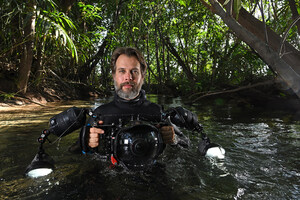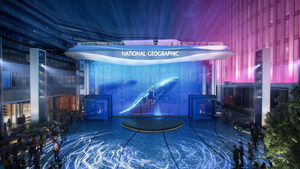Ten Grants That Illuminated the World
National Geographic Grantmaking Reaches 10,000 Mark
WASHINGTON, Dec. 8, 2011 /PRNewswire-USNewswire/ -- Excavation of the lost Inca city of Machu Picchu by archaeologist Hiram Bingham. Jane Goodall's groundbreaking study of wild chimpanzees. The pioneering exploration of the deep sea by Jacques-Yves Cousteau. All the legacy of National Geographic grants.
(Photo: http://photos.prnewswire.com/prnh/20111208/DC19219)
It began in 1890 with a single grant to explore the uncharted Mount St. Elias region of Alaska. Since then the National Geographic Society has funded grants to every corner of the Earth — unlocking many of its secrets, sometimes in spectacular ways. Late in 2011, the total number of National Geographic grants reached 10,000, representing a combined value of $153 million. Conservation biologist Krithi Karanth, 32, of India is the recipient of the 10,000th grant, and a story highlighting this milestone will appear in the January issue of National Geographic magazine.
"The impact and results of these 10,000 grants are beyond calculation — they have filled countless gaps in our knowledge of the Earth and all that lives on it," said John Francis, vice president for research, conservation and exploration at National Geographic. "The urgent need for solutions to the planet's pressing problems means that the next 10,000 grants will be even more critical."
The 'Top 10'
From all of the grants made so far, the National Geographic Society has chosen 10 that have made the greatest difference in understanding the Earth (listed chronologically):
1912-15: Excavation of the "lost city of the Inca" — Machu Picchu in Peru. Grantee: Hiram Bingham. Other key National Geographic-funded archaeology projects include extensive investigation of Central America's Maya culture and ancient Egypt; Neil Judd's excavation at Pueblo Bonito in Chaco Canyon; Matthew Stirling's finds from ancient Olmec culture in Mexico; Johan Reinhard's discovery of the well-preserved "Ice Maiden" Inca sacrifice; and Guillermo Cock's finds of thousands of Inca mummy bundles near Lima, Peru. Contemporary example: Archaeologist William Saturno's exploration and excavation of Maya murals at San Bartolo.
1928-9: Man's first flight over the South Pole, photographing 60,000 square miles of Antarctica from the air. Grantee: Richard E. Byrd. Related achievements funded by National Geographic include Robert Peary and Matthew Henson's 1909 North Pole expedition; the altitude record in the Explorer II balloon set by Capts. Orvil Anderson and Albert W. Stevens; and Will Steger's record-setting polar expeditions. Contemporary example: Norwegian polar explorer Borge Ousland's four expeditions.
1952: Pioneering exploration of hidden ocean life by Jacques-Yves Cousteau, beginning with underwater excavation of an ancient Roman cargo ship near Marseille, France — the first of 37 grants made to Cousteau. Other National Geographic grants that sent people into the oceans: a record dive in a bathysphere a half-mile below the sea by William Beebe and Otis Barton; Eugenie Clark's 13 grants exploring ocean life, especially sharks; and pioneering ocean exploration by "Her Deepness" Sylvia Earle. Contemporary example: Marine ecologist Enric Sala's work to explore and conserve the ocean's last pristine places.
1960: Search for evidence of early humans in Africa. Grantee: Louis Leakey. This was the first of a total of 76 National Geographic grants to Leakey and his wife, Mary; their son Richard; and his wife, Meave Leakey. The results were a string of finds of the fossils of early humans, beginning with the discovery of manlike Zinjanthropus and continuing today. Others who have led the effort to piece together humans' past with National Geographic funding: Donald Johanson, Tim White and Lee Berger. Contemporary example: Zeray Alemseged's discovery in Ethiopia of the world's oldest fossil infant, dating from 3.3 million years ago.
1961: Field study of wild chimpanzees, which confirmed use of tools by a species other than humans and unveiled the species' rich social structure. Grantee: Jane Goodall. Other groundbreaking work with primates includes Dian Fossey's 20 grants for work with mountain gorillas, Birute Galdikas's 11 grants for pioneering field study of orangutans; Jill Pruetz's ongoing research on savanna chimpanzees. Contemporary example: Jacinta Beehner, who works with gelada monkeys in Ethiopia.
1963-8: Conservation grant to help establish Redwood National Park, which followed a 1916 grant to preserve endangered tracts of old-growth trees at the heart of Sequoia National Park. Grantee: Chester C. Brown (National Park Service). Other conservation efforts include J. Michael Fay's Megatransect, which led to creation of 13 national parks in Gabon. Contemporary example: Work of Claudio Campagna to create Sea and Sky conservation area in Patagonia.
1970: Mapping the ocean floor, creating a global panorama of the ocean floor and revealing an ocean bed fractured by large mountain chains. Grantees: Bruce Heezen and Marie Tharp. Also, the NGS-Palomar Observatory Sky Survey, the first mapping of the night sky from North America, and Brad Washburn's detailed mappings of the Grand Canyon and Mount Everest. Contemporary example: The indigenous mapping project of Papua New Guinea by Mac Chapin.
1975-6: Discovery of the location of the wintering grounds of the eastern North American monarch butterfly. Grantee: Fred Urquhart. Thousands of grants for wildlife research include John and Frank Craighead's study of grizzly bears, leading to advances in wildlife study tools such as radiotracking and biotelemetry; George Schaller's pioneering field observations of the poorly known wildlife of the mountains of South Asia; Merlin Tuttle's trail-blazing work on bats; Jared Diamond's discoveries of the little-known birds of Papua New Guinea; and Barbara Block's research on the highly endangered bluefin tuna. Contemporary example: Martin Wikelski, who is producing new insights on migrating birds and insects using miniaturized radiotransmitters.
1977: Discovery of hydrothermal vents deep in the Pacific Ocean's Galapagos Rift, containing the first known life forms not dependent on photosynthesis. Grantee: Robert Ballard. Ballard went on to discover the wreck of the RMS Titanic as well as Bismarck, PT 109 and dozens of ancient wrecks. Also, George Bass's pioneering of underwater archaeology while excavating Bronze Age shipwrecks. Contemporary example: Deborah Carlson, excavating an ancient Roman stone-carrier ship off the coast of Turkey.
2004: Discovery of missing-link fossil of 375 million-year-old fossil fish representing transition of life from sea to land. Grantee: Neil Shubin. Numerous grants have funded paleontology around the globe, including the discovery of new dinosaur species on nearly every continent by Paul Sereno; Tom and Pat Rich's work collecting vertebrate fossils in Australia's "Ghastly Blank"; and Philip Gingerich's connecting of fossilized whales with feet to ungulates. Contemporary example: Xu Xing, studying the origin of bird flight through discovery of fossilized feathered dinosaurs.
Old and New
Most of National Geographic's 10,000 grants were made by the century-old Committee for Research and Exploration; others came from the Society's newer grant-making groups: Expeditions Council, Conservation Trust, National Geographic-Waitt Grants, Young Explorers Grants, Genographic Legacy Grants, Big Cats Initiative and All Roads Film Project.
Scientific research, exploration, conservation and adventure are the backbone of National Geographic's grants; the scientific grants focus primarily on anthropology, archaeology, biology, ecology, geology, geography, oceanography and paleontology. National Geographic grants have led to countless discoveries that continue to shed light on the planet's rich variety and diversity — and help preserve it.
The first grant came about in 1890, when the 2-year-old National Geographic Society was interested in pushing the horizons a bit, perhaps launching an exploration program that would increase geographic knowledge in a new way. That was when a member of the board of managers suggested sending out a team to map the unexplored region of Canada's Mount St. Elias. A few other teams had tried to explore that mountain, but had been turned back by menacing weather and avalanches.
In the end, the expedition's chosen leader, geologist and engineer Israel C. Russell, didn't make it to the top of Mount St. Elias either — ferocious weather and avalanches drove him and his team back over and over — but they returned with a wealth of scientific information, including the first sighting ever of Mount Logan, Canada's highest peak.
Young Indian Biologist Gets No. 10,000
Conservation biologist Krithi K. Karanth of Bangalore, India, is the recipient of the 10,000th grant. Dr. Karanth saw her first wild tigers at the age of 2 at the side of her father, wildlife biologist and conservationist Ullas Karanth. Krithi Karanth works on human dimensions of conservation, such as human-wildlife conflicts, land use change and people-park relationships. With the National Geographic grant, she will assess human-wildlife conflicts in five parks of India's Western Ghats. The project will identify and map risks and consequences for local people and the implications for conflict-prone wildlife species such as elephants, wild pigs, leopards and tigers. Field methods will include thousands of household surveys, interviews and mapping exercises.
India's rich wildlife has been severely reduced over the past century and continues to be threatened by habitat destruction, prey depletion, poaching and the global wildlife trade.
"The declines of species are so dramatic, widespread and so recent," Karanth said. "I wish I could have seen what the country was like in the 1800s with all this wildlife. In many parts of India there is human tolerance for some species, and this is why they still persist despite rapid changes in land use and high densities of people. This 'cultural' tolerance must be harnessed."
SOURCE National Geographic Society
WANT YOUR COMPANY'S NEWS FEATURED ON PRNEWSWIRE.COM?
Newsrooms &
Influencers
Digital Media
Outlets
Journalists
Opted In




Share this article